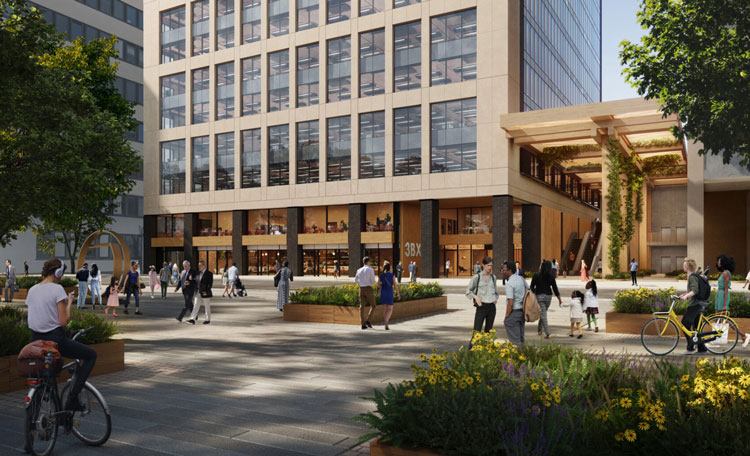Property Outlook: 2023 A Tale of Two Halves
LONDON, 9 March, 2023 – Global real estate advisor, Cushman & Wakefield has released its European Macro Outlook, forecasting they expect a mild recession to occur in the U.K. and the euro area in the first half of 2023, followed by improving growth in the latter half as the macro headwinds begin to fade. Although the near-term outlook looks brighter than many expected just six months ago, there remain some risks to the growth forecast.In brief, the report anticipates:
- A mild recession in the UK and the euro area in 2023.
- Price discovery in capital markets to be further tested as higher interest rates percolate through markets.
- Demand for high-quality office will intensify but will soften for lower grade space.
- Vacancy in logistics to remain near record lows despite slight uptick.
- Outward shift in yields to be relatively contained in retail.
- Alternatives to outperform.
Sukhdeep Dhillon, Head of EMEA Forecasting at Cushman & Wakefield, said: “Any recession, even a mild one, poses a challenge for both occupiers and investors. Our research suggests that rate hikes and inflation are expected to weigh heavily on economic growth in 2023. While the intensely local nature of real estate means that some sectors and geographies will perform better than others, growth is nonetheless beginning to gather momentum if you know where to look.
“Recessions create opportunities. During periods of volatility such as this, it’s important to remember that real estate is a long-term investment, with many able to reap healthy cumulative returns even during a recession.
There will be variation at the city and asset level. Many assets will outperform in particular the prime end of the market that is largely undersupplied. The most mobilised buyers will be rewarded with opportunities that might have otherwise been out of reach just 12 to 18 months ago.”
Capital markets
2022 had a positive start, with investment volumes at high levels–first quarter volumes were 33% above the five-year average (2017-2021) and 39% above 2021 levels in Europe. As economic uncertainty and confidence about the outlook worsened throughout 2022, transaction volumes followed suit, posting significant declines in the second half of the year. The fourth quarter was particularly slow, recording the lowest volume of the year overall. Typically, Q4 is the most active, as there is tremendous seasonality in investment activity. Transaction volumes were down across all property sectors in 2022, registering a 25% decline. The most impacted sectors were logistics and residential, which had stronger performances throughout the pandemic.
“In the aggregate, we still expect further movement in yields across all property sectors in the first part of 2023 as commercial real estate continues to adjust to the higher-risk, higher interest rate environment. But we also know there is tremendous capital waiting on the sidelines ready to pounce. It’s a waiting game until the contours of this recession and interest rates become more visible. As the unknowns become knowns, the capital will be deployed aggressively,” Dhillon said.
Office
The relationship between office-based employment and office demand decoupled in the wake of hybrid and remote working. However, the office sector in the euro area registered positive net absorption of 3.5 million square meters (sqm) in 2022, led by Paris (Western Crescent), Copenhagen and Madrid. Despite the outperformance of office-related jobs during the pandemic recovery, the office vacancy rate in Europe still hovers around 8% as of Q4 2022 (unchanged from Q4 2021) and is still 200 bps above the pre-pandemic rate of 6%.
“We are beginning to see encouraging signs that the shift toward hybrid and remote working and the concomitant impacts on office demand have been realised across most markets across Europe, but the impact has not been uniform. Demand for high-quality offices in desirable locations will intensify as occupiers focus on employee wellbeing and experience. We also expect the flight to quality to result in weaker demand for lower grade space. That said, many investors are eyeing that same challenged space as ideal candidates for repositioning or repurposing to hit higher returns down the road,” said Dhillon.
Retail
Although a mild recession will keep consumer spending in check, as we expect inflation to fall substantially in H2 2023 (allowing real wage growth to resume), consumer confidence, and subsequently consumer spending, is expected to improve. Cushman & Wakefield believes that after a brief correction in prime rental levels of 0.2% in 2022 and stability in 2023, a recovery in leasing activity will take hold, translating into positive rental growth and averaging 2.1% across Europe in 2024.
“The retail sector has been constantly evolving over the last half-century, with many retailers already having undertaken significant cost cutting and painful adjustments, particularly during the early years of e-commerce penetration and more recently, during the pandemic. This, in effect, will help the sector withstand the upcoming recession, and why we expect retail vacancy to tick up slightly in 2023 before starting to trend down gradually from 2024,” explained Dhillon.
Logistics
The uncertain economic environment had little impact on logistics demand during the first half of 2022. Ultimately, however, the rise in debt costs, uncertainty surrounding the economic outlook and inflation, and the concomitant slowdown in consumer spending caught up. Take-up for the sector across Europe, settled at 8.6 million sqm, representing a 29.8% decline over the previous year and -2.1% compared to the previous quarter. That said, even with the slowdown, demand for logistics space remained robust relatively to any year prior to the pandemic and vacancy remains at historically low levels across Europe.
Although there is a significant amount of uncertainty around the geopolitical landscape, global supply chain pressure continues to provide relief. The global supply chain stress index fell from its peak of 4.31 in December 2022 to 0.95 in January 2023, but it remains above its pre-pandemic level.
Against this backdrop, Cushman & Wakefield expects demand and take-up to moderate in the short term before picking up in H2 2023, as more clarity emerges around the consumer outlook. Even with moderation, occupier demand will remain robust and should continue to come in above pre-pandemic levels in the coming years. The search for prime logistics buildings that are strategically located, near transport hubs, and well connected to the road network will intensify as occupiers strive for operational and cost-efficiency in a challenging economic environment.
“Although we continue to forecast a deceleration in rental growth in the short term, with a 3.9% and 2.2% rental increase in 2023 and 2024, the vacancy rate remains very low compared to historical levels and it should continue to provide upward pressure to prime rents in the sector. As demand for goods picks up, warehousing space will remain sought after - but in short supply, pushing occupiers into considering secondary buildings and alternative locations,” said Dhillon.
Alternatives
Investor interest in alternatives continues to rise, with the level of investment in EMEA reaching €58 billion in the last five years. The alternatives sector is attractive to investors because it is less correlated with economic growth – meaning more resilient to cyclical swings - and therefore offers investors the portfolio diversification they need, particularly during uncertain times. The sector also presents inflation and performance hedging characteristics, which are particularly attractive to investors in the present high-inflation environment.
“Ageing populations and the pandemic have spurred an acceleration in investment in many strands of the alternative sector, including life sciences, data centres and later living, with the sector faring better than the traditional sectors within real estate. Investors will find opportunities correlated with underlying structural trends will do particularly well, even during a mild recession,” said Dhillon.
Note to Editors: Retail in this report refers specifically to Prime High Street Retail




